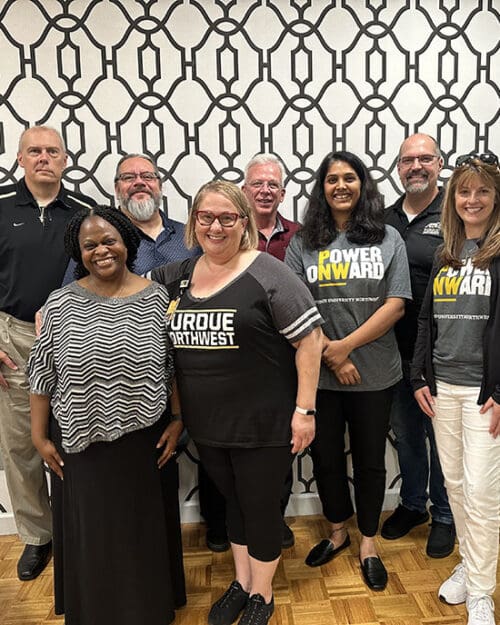Finding truth in the numbers

Purdue University Northwest staff members in the office of Institutional Effectiveness and Data Analytics pose for a group photo during the 2024 PNW faculty and staff resource fair.
Learn how PNW faculty and staff can collaborate with the office of Institutional Effectiveness and Data Analytics
Purdue University Northwest’s (PNW) office of Institutional Effectiveness and Data Analytics provides a wide range of services that meet internal and external needs for university data reporting, from enrollment predictions and census to academic and institutional accreditation as well as compliance. With a team of data analysts, stewards and architects, Institutional Effectiveness and Data Analytics serves as the bridge between available institutional data and PNW faculty and staff members’ data questions to inform their business goals.
Read on to learn more from Ashlesha Bharat Pawar, executive director of Institutional Effectiveness and Data Analytics, and Gillian Leonard, director of Compliance and Data Governance, on how PNW faculty and staff can best partner with the office and its services.
How would you describe your unit’s scope of services provided to the campus community?
Recently, Institutional Effectiveness and Data Analytics transitioned from its former name, Institutional Research. This was intentionally done in order to better capture the swath of services we offer.
The “institutional effectiveness” part speaks to our role in supporting improvements in quality for different aspects of the institution. This can include program assessment and accreditation, strategic planning and internal process improvements that align with institutional priorities. These facets support our evidence-based culture that help us measure how well our institution is moving toward its goals and objectives.
“Data analytics,” on the other hand, refers to how we help campus partners find insights through data dives, interpret the available information and increase data literacy. There are different levels of data analytics our unit can provide, from descriptive statistics on demographics to more diagnostic analyses on what impacts retention rates to predictive analyses like our enrollment forecasts. Through these functions, we can help make recommendations for campus partners in order to take data-informed action steps.
What are some of the different deliverables your office will work on each year?
Our annual campus census report, and the enrollment snapshots leading up to that date in the fall, is a report that we share with campus leaders and stakeholders that helps with predictions and decision-making leading up to the finalized census numbers.
Our unit will perform compliance reporting for the Indiana Commission for Higher Education, the Higher Learning Commission, the Integrated Postsecondary Education Data System (IPEDS), the National Collegiate Athletics Association (NCAA) and more.
Some of our projects will be cyclical, such as the Beginning College Survey of Student Engagement (BCSSE), Faculty Survey of Student Engagement (FSSE), and the National Survey of Student Engagement (NSSE), all of which provide valuable feedback from the surveyed audiences on their observations and expectations for their learning environments.
Some of our projects serve external audiences, like prospective students, through the Common Data Set. This is used among many higher education institutions in which they can report information about program offerings, financial aid and more that informs listings in College Board, U.S. News & World Report and Peterson’s.
Explore Reports From the Office of Institutional Effectiveness and Data Analytics
Are there misconceptions about your unit you may want to clarify?
A common misconception is that all we do is generate numbers. While, yes, numbers are obviously a core element of data, our larger goal is to help the university community gain insights that can help everyone succeed. We often function as analytic translators where we are the bridge between the available data and the business goals.
Another misconception is that people will assume we will provide everything they ask for. We do not have a green light to necessarily share all pieces of data. Some data is classified as sensitive and cannot be released due to federal laws or institutional policies. However, in the case of sensitive data, we can use a proxy piece of information that still meets the nature of your question.
What is data literacy and how does one improve this skill?
We view “data literacy” as the ability to read, analyze and work with available data with an understanding that can turn it into actionable insights. It does not require math expertise, but rather it requires an understanding of how to put data in context and interpret for a specific need or purpose.
Just like learning a new language, you need to have a vocabulary, base dialect, different degrees of proficiency and a process for developing that language.
Our unit is in the process of building a business glossary that will help campus partners with establishing a base vocabulary and helping build colleagues up to a level of proficiency where they feel comfortable. Sometimes, as a whole, we are data rich but information poor, so that is where our unit can help increase fluency and inform the campus community beyond just the raw numbers.
How can campus community members best partner with your unit?
When there is a data request for a project, we should understand the project’s purpose, the audience you are looking to serve and how you want to deliver this information. Context is key, because that will help us understand how to serve your business questions, apply correct filters with data and arrive at actional numbers we can share. We want to be able to help you communicate with the data-derived message.
Engage with us early and often. When you are starting on a project, we want to be able to start on the ground floor with you in the process. Help us to understand the business needs, goals and deadlines you have, and define and refine your questions. Collaboration is one of the key ways we will be able to provide accurate and insightful data.